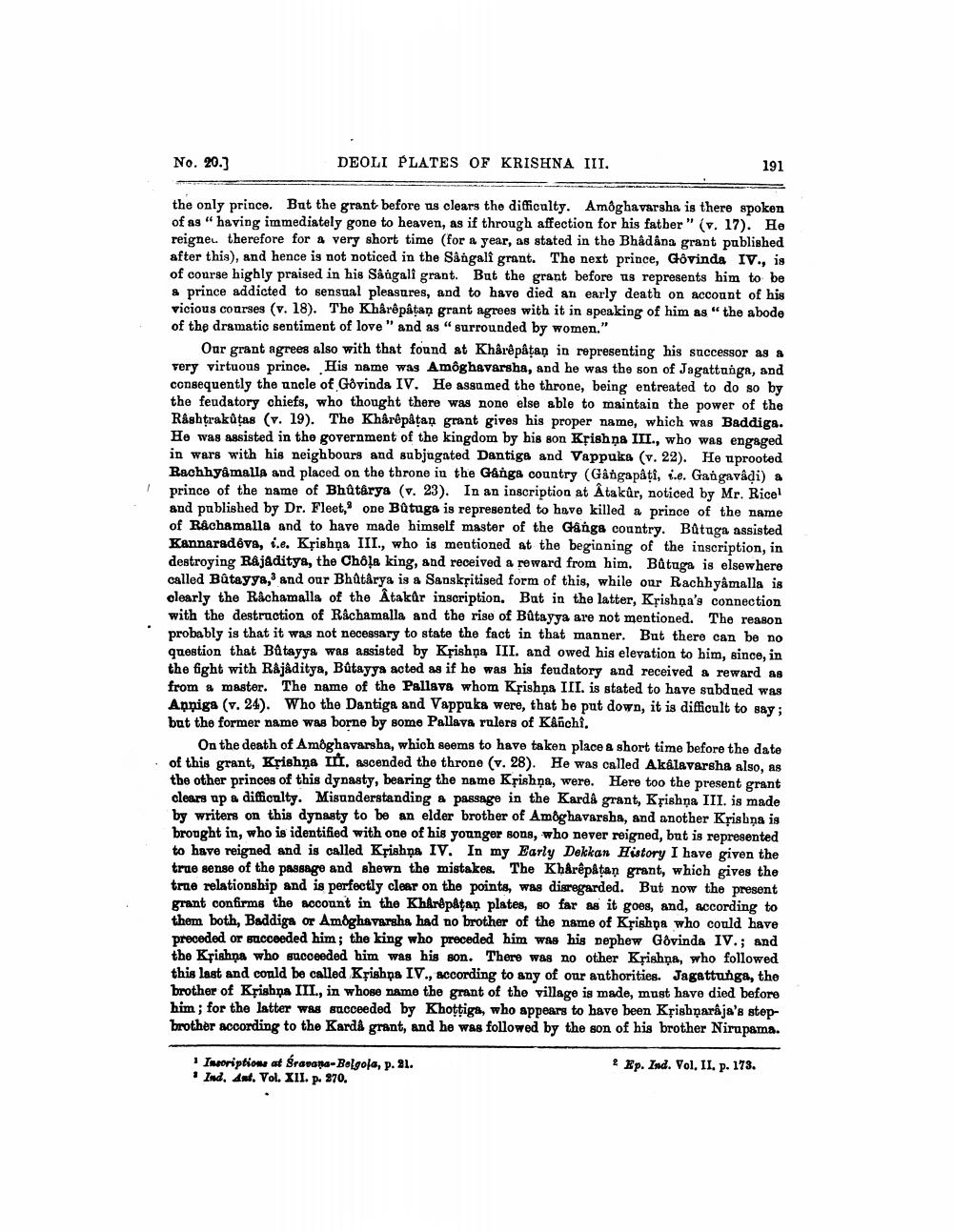________________
No. 20.3
DEOLI PLATES OF KRISHNA III.
191
the only prince. But the grant before us clears the difficulty. Amoghavarsha is there spoken of as “having immediately gone to heaven, as if through affection for his fatber" (v. 17). He reigne. therefore for a very short time (for a year, as stated in the Bhâdâna grant published after this), and hence is not noticed in the Sångali grant. The next prince, Govinda IV., is of course highly praised in his Saugali grant. But the grant before us represents him to be & prince addicted to sensual pleasures, and to have died an early death on account of his vicious courses (v. 18). The Khårêpåtan grant agrees with it in speaking of him as "the abode of the dramatio sentiment of love" and as "surrounded by women."
Our grant agrees also with that found at Khârêpâţaņ in representing his successor as a Fery virtuous prince. His name was Amôghavarsha, and he was the son of Jagattunga, and consequently the uncle of Govinda IV. He assumed the throne, being entreated to do so by the feudatory chiefs, who thought there was none else able to maintain the power of the Rashtrakūtas (v. 19). The Khårêpåțan grant gives his proper name, which was Baddiga. He was assisted in the government of the kingdom by his son Krishna III., who was engaged in wars with his neighbours and subjugated Dantiga and Vappuks (v. 22). He uprooted Rachhyamalla and placed on the throne in the Ganga country (Gangapâţi, i.e. Gangavadi) a prince of the name of Bhatarya (v. 23). In an inscription at Âtakûr, noticed by Mr. Rice! and published by Dr. Fleet, one Batuga is represented to have killed a prince of the name of Rachamalla and to have made himself master of the Ganga country. Butaga assisted Kannaradeva, i.e. Krishna III., who is mentioned at the beginning of the inscription, in destroying Rajaditya, the Chôļa king, and received a reward from him. Batuga is elsewhere called Bûtayya, and our Bhatarya is a Sansksitised form of this, while our Rachhyamalla is clearly the Rachamalla of the Atakur inscription. But in the latter, Krishna's connection with the destruction of Rachamalla and the rise of Batayya are not mentioned. The reason probably is that it was not necessary to state the fact in that manner. But there can be no question that Bû tayya was assisted by Krishga III. and owed his elevation to him, since, in the fight with Rajâditya, Bútayya acted as if he was his feudatory and received a reward as from & master. The name of the Pallavs whom Kệishņa III. is stated to have subdued was Anniga (v. 24). Who the Dantiga and Vappuks were, that be put down, it is difficult to say: but the former name was borne by some Pallava rulers of Kanchi.
On the death of Amoghavarsha, which seems to have taken place a short time before the date of this grant, Krishna . ascended the throne (v. 28). He was called Akalavarsha also, as the other princes of this dynasty, bearing the name Krishna, were. Here too the present grant clears up a difficulty. Misunderstanding a passage in the Karda grant, Krishna III. is made by writers on this dynasty to be an elder brother of Amoghavarsha, and another Krishna is brought in, who is identified with one of his younger sons, who never reigned, but is represented to have reigned and is called Krishna IV. In my Early Dekkan History I have given the true sense of the passage and shewn the mistakes. The Khårêpåtan grant, which gives the true relationship and is perfectly clear on the points, was disregarded. But now the present grant confirms the account in the Khårêpåtap plates, so far as it goes, and, according to them both, Baddiga or Amoghavarsha had no brother of the name of Krishpa who could have preceded or succeeded him; the king who preceded him was his nephew Govinda IV.; and the Krishna who succeeded him was his son. There was no other Krishna, who followed this last and conld be called Krishna IV., according to any of our anthorities. Jagattunga, the brother of Krishna III., in whose name the grant of the village is made, must have died before him; for the latter was succeeded by Khottige, who appears to have been Krishnaraja's stepbrother according to the Kardå grant, and he was followed by the son of his brother Nirupama.
Ingription at śrarana-Bolgola, p. 21. Ind. Ant. Vol. XII. p. 870.
2 Ep. Ind. Vol. II, p. 173.




